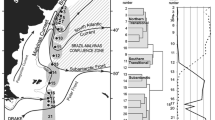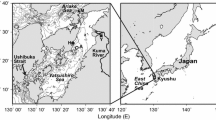Summary
The upper and/or lower temperature limits for growth of 43 marine diatoms have been determined. According to the extent of the temperature tolerance range for growth and its position within the ecological relevant temperature range, the diatoms were divided in oligo-eurytherm (cold-, temperate-, warm-), meso-eurytherm (cold-, warm-) and eu-eurytherm species.
The definition of the terms cosmopolites and circum-tropical could be enlarged, when the experimentai results and the distribution data from literature (19 distribution maps were combined.
The results showed a significant relation between lower temperature limit for growth and both volume and cell size. In this way the lower temperature limit influences the size distribution of the phytoplankton in the oceans. Large diatoms are absent in cold water because of their high lower temperature limit for growth.
The use of experimental results to reduce the number of sampling stations for determination of geographical distribution of diatoms, is discussed.
Similar content being viewed by others
References
BAINBRIDGE, V., 1960. The plankton of inshore waters off Freetown, Sierra Leone. Colon. Off. Fish. Publs., 13:1–48.
BRAARUD, T., 1962. Species distribution in marine phytoplankton. J. Oceanogr. Soc. Japan, 20th Anniversary, 20:628–649.
BUNT, J.S., 1968. Some characteristics of microalgae isolated from antarctic sea ice. Antarctic Res. Ser., 11:1–14.
CLEVE, P.T., 1896. Diatoms from Baffins Bay and Davis Strait. Bihang Till K. Svenska Vet. Akad. Handlingar., Bd. 22, Afd.3, No.4:1–22. Pl1–2.
CLEVE, P.T., 1900. The seasonal distribution of Atlantic plankton organisms. Göteborg.
DREBES, G., 1974. Eine Auswahl der Helgoländer Planktonalgen (Diatomeen, Peridineen). Stuttgart: George Thieme Verlag, 186 pp.
EKMAN, S., 1953. Zoogeography of the Sea. Sidgwick and Jackson, London, 417 pp.
FRYXELL, G.A. and G.R. HASLE, 1972.Thalassiosira eccentrica (EHRENB.) CLEVE,T. symmetrica sp. nov., and some related centric diatoms. J. Phycol. 8:297–317.
GIFFEN, M.H. 1973. Diatoms of the marine littoral of Steenberg's Cove in St. Helena Bay, Cape Province, South Africa. Bot. Mar., 16:32–48.
GRØNTVED, J. and G. SEIDENFADEN, 1938. The phytoplankton of the waters west of Greenland. Medd. om Grønland, 82(5):1–380.
HASLE, G.R., 1976. The biogeography of some marine planktonic diatoms. Deep-Sea Research, 23:319–338.
HEIDEN, H. and R.W. KOLBE, 1928. Die marinen Diatomeen der Deutschen Südpolar-Expedition, 1901–1903. Deutsche Südpolar-Expedition, 8, Botanik, 5:447–715.
HUSTEDT, F., 1956. Einführung in die Kleinlebewelt. Kieselalgen. (Diatomeen). Kosmos-Verlag-Franckh. Stuttgart.
JAHNKE, J., 1977. Laborversuche zum einfluss des Tageslichtganges auf die Wachstumsrate vonBiddulphia sinensis GREVILLE undCoscinodiscus granii GOUGH. Diplomarbeit, Abt. Syst. Geobot., RWTH Aachen.
MAKAROVA, I.V., 1971. K. biogeografii rodaThalassiosire Cl, Botanicheskii shurnal Akademii Nauk S.S.S.R., 56:1459–1476.
MARUMO, R. and T. MINODA, 1976. Phytoplankton in the subarctic and tropical waters in the Pacific. Mar. Sci. Commun., 2:269–282.
MOREIRA FILHO, H., 1961. Diatomáceas da Baia de Guartuba. Bol. Univ. Paraná, Dep. Bot. Farmacog., Bot. No.3:1–35.
MOREIRA FILHO, H., 1964. Contribuição ao estudo das diatomáceas da região de Cabo Frio. Bol. Univ. Paraná, Dep. Bot. Farmacog., Bot., No. 14:1–11.
SACHS, L, 1972 Statistische Auswertungsmethoden. 3 Aufl. Berlin/Heidelberg/New York.
SEMINA, H.J., 1972. The size of phytoplankton cells in the Pactific Ocean. Int. Revue ges. Hydrobiol., 57:177–205.
SILVA, E.S. e J.S. PINTO, 1952. Estudo do cicio sazonal de plåncton marinho da Guiné Portuguesa. Bol. Cult. Guiné Portug., 7:131–155.
SMAYDA, T.J., 1958. Biogeographical studies of marine phytoplankton. Oikos, 9:158–191.
STOSCH, H.A. von und G. DREBES, 1964. Entwicklungsgeschichtliche Untersuchungen an zentrischen Diatomeen. 4. Die PlanktondiatomeeStephanopxis turris, ihre Behandlung und Entwicklungsgeschichte. Helgol. wiss. Meeresunters., 11:209–257.
WERNER, D., ed. 1977. The biology of diatoms. Botanical monographs. Volume 13. Blackwell Sci.Publ.
WOOD, E.J.F., 1964. Studies in microbial ecology of the Austraiasian Region. 4. Some quantitative aspects. Nova Hedwigia, 8:453–461. Plates 94(7)-112(25).
Author information
Authors and Affiliations
Rights and permissions
About this article
Cite this article
Baars, J.W.M. Autecological investigations on marine diatoms. I. Experimental results in biogeographical studies. Hydrobiological Bulletin 13, 123–137 (1979). https://doi.org/10.1007/BF02284748
Published:
Issue Date:
DOI: https://doi.org/10.1007/BF02284748




